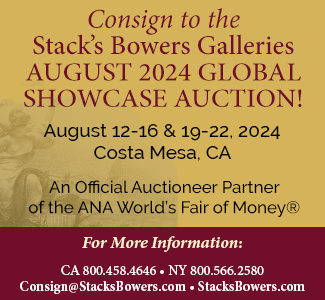Coin Rarities & Related Topics: News and Analysis regarding scarce coins, coin markets, and the coin collecting community #275
….
A Weekly CoinWeek Column by Greg Reynolds
In Schaumburg, Illinois, a small city not far from Chicago, the annual CSNS convention was held from April 22nd to 25th. The focus here is on rare U.S. silver and gold coins, including condition rarities, in the Heritage Platinum Night event on Thursday, April 23. The whole Heritage auction, which contained thousands of lots and totaled more than $46 million, is just too large to meaningfully review in one discussion. Herein, I mention coins that are especially newsworthy, a few of which may be the finest known of their respective dates.
Stellas – $4 Gold Patterns
 The most talked about result is $1,821,850 for the NGC graded 67, and CAC approved, 1880 Coiled Hair $4 gold pattern (Stella). Some background information is provided in my recent preview of this auction. (Clickable links are in blue.)
The most talked about result is $1,821,850 for the NGC graded 67, and CAC approved, 1880 Coiled Hair $4 gold pattern (Stella). Some background information is provided in my recent preview of this auction. (Clickable links are in blue.)
Richard Burdick found this 1880 Coiled Hair Stella to be “original and beautiful, definitely 67, the best Stella I have ever seen. There is a world of difference between this one and the 1880 that is NGC certified 67-Cameo.”
John Albanese was involved in the bidding, as was Matt Kleinsteuber, though I do not know who bought it. “Clearly the best Stella I have ever seen, of any type,” Matt declares, “no problem grading 68. The price was very fair.”
Burdick agrees, “the price was fair. I was thinking that it might bring $2 million.” Indeed, in a conversation with Burdick well before the auction, Richard seemed to be thinking of this 1880 Coiled Hair Stella as a $2 million item in the current market environment.
John Albanese remarks that the $1,821,850 result was “a wholesale price.” Albanese is the founder and president of CAC. John is quoted regarding this Stella in my preview.
In contrast, Albanese declares that the $881,250 result for the 1879 Coiled Hair Stella was “a very strong price!” This 1879 is PCGS graded 65, and CAC approved. Albanese “bid $564,000.”
The 1880 Flowing Hair Stella is extremely rare, too. It is the 1879 Flowing Hair Stella that is not rare.
The 1880 Flowing Hair Stella in this sale is PCGS graded 65. It brought $517,000, a strong price, certainly a retail level. A wholesale price would probably have been in the range of $420,000 to $480,000.
In regards to Stellas, I cite numerical grades without repeating the term Proof over and over again. Although they are always certified as Proofs, I contend that some Stellas should be designated as Specimens rather than as Proofs. Some were struck once, softly and unevenly, and have much ‘mint luster’ like that of business strikes. As Stellas are not business strikes, though, and are all patterns, there is not a need to emphasize points regarding methods of manufacture.
1933 Indian Head $10 Gold Coin
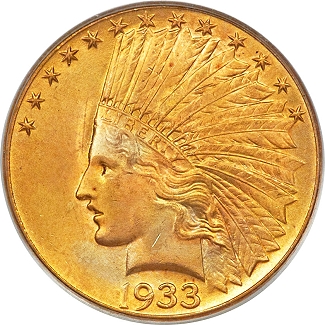 The 1933 is the key to the series of ‘With Motto’ Indian Head eagles. This PCGS graded and CAC approved MS-65 1933 Eagle ($10 gold coin), from the NOC consignment, sold for $822,500. It is in a holder with an old green label. Many market participants figured that this price was strong.
The 1933 is the key to the series of ‘With Motto’ Indian Head eagles. This PCGS graded and CAC approved MS-65 1933 Eagle ($10 gold coin), from the NOC consignment, sold for $822,500. It is in a holder with an old green label. Many market participants figured that this price was strong.
I am not agreeing that this price is strong. The Kruthoffer 1933 was NGC graded MS-66 when Stack’s (NY) auctioned it for $718,500 in October 2004. Although $718,500 was a strong price at the time, markets for rare coins were booming from then until the middle of 2008. Most or all of the serious bidders in 2004 knew that the Kruthoffer 1933 had previously been PCGS graded MS-65.
The Kruthoffer 1933 is now PCGS graded as “MS-65+.” As that coin brought $718,500 in 2004, it is not surprising that this one, which is at least equal and is likely to be better in the views of most experts, sold for $822,500 in 2015.
About the NOC 1933 that just sold, “magnificent coin, hands down, the best 1933 eagle I have ever seen,” Richard Burdick declares. Richard has been carefully viewing 1933 eagles for more than forty years.
1799 Bust $10 Gold Coin
One of the strongest prices in this auction was $376,000 for a 1799 eagle. This coin is PCGS graded MS-65, and CAC approved. Like many of the coins in the NOC consignment, it is in a PCGS holder with an old green label from the 1990s. Although the pre-auction PCGS price guide value of “$276,000” was too low, $320,000 would have been a strong price.
Albanese states that “the 1799 is the most common bust eagle,” and the $376,000 price is “definitely retail.” Of the five MS-65 grade 1799 eagles “that have CAC stickers, it is one of the top two,” John reveals.
Jim McGuigan likewise states that “it is one of the best I have ever seen and is conservatively graded, a really nice coin.” For decades, McGuigan has been a specialist in U.S. coins dating from 1793 to the 1830s.
$705,000 for An Esoteric Die Variety!
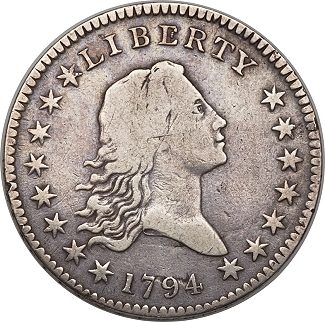 A collector could buy two gem quality, bust eagles for the price realized for one, NGC graded VF-25 1794 half dollar of the O-109 variety, which refers to a specific pair of obverse and reverse dies. (In order to make coins, an obverse die and a reverse die are secured in a coining press and used to impart designs on prepared circular blanks.)
A collector could buy two gem quality, bust eagles for the price realized for one, NGC graded VF-25 1794 half dollar of the O-109 variety, which refers to a specific pair of obverse and reverse dies. (In order to make coins, an obverse die and a reverse die are secured in a coining press and used to impart designs on prepared circular blanks.)
Sheridan Downey refers to the assigned VF-25 grade as “NGC generously graded” and says that “$100,000 would be about right” for this coin. Downey is a long-time specialist in early half dollars.
This unique die variety of a 1794 half dollar, which is referenced as O-109, brought a super-strong price, $705,000, more than six times the respective maximum estimates of most pertinent experts. Except for readily apparent major varieties that are sometimes collected as distinct dates, no die variety of a date of any U.S. coin that is not otherwise rare had sold for as much as $100,000 at auction.
This is not a major variety; it is necessary to inspect the coin closely to identify the O-109 die pairing. Indeed, even most full-time coin dealers would have to consult a reference guide to determine that this coin is of a rare variety.
This coin does not appear much different from many other 1794 half dollars. There are a few collectors who seek to obtain representatives of every pair of dies that was used to strike early half dollars.
1802 Half Dime
It is less difficult to obtain an 1802 half dime than prohibitively rare die varieties of 1794 halves. The 1802 is extremely rare overall and is the only rarity, as a date, among Flowing Hair, Draped Bust and Capped Bust half dimes.
After obtaining an 1802, completing the rest of a set ‘by date’ of early half dimes is not particularly difficult. Also, the only date in the series of Liberty Seated half dimes that costs more than $1500 in all grades is the unique 1870-S.
The Hilt 1802 in this auction is “bent” and is non-gradable. It may have additional problems. Jim McGuigan was not impressed by it. This 1802 has the details of a Fine grade coin and it brought $49,350, a moderate to slightly strong price.
Early Dimes
In addition to the already discussed $705,000 1794 half dollar and just mentioned 1802 half dime, the portion of the legendary Hilt Collection that was consigned to this auction also featured an 1804 dime, which is the key to the series of Draped Bust, Heraldic Eagle dimes. This 1804 is of the variety with fourteen stars on the reverse, the rarer of the two major varieties, which are sometimes collected ‘as if’ they are two distinct dates. This 1804 is NGC graded Fine-12 and realized $19,975, clearly a strong price.
The $35,200 result in this auction for the PCGS graded and CAC approved MS-65 1805 dime is not easy to interpret, though it is certainly not weak. This result is much higher than the prices realized for several different, NGC graded MS-65 1805 dimes over the last seven years.
A PCGS graded and CAC approved MS-66 1807 dime went for $64,625. Indisputably, this is a strong price. Even $53,000 would have been a retail price for this coin.
A Proof 1821 dime is of extraordinary importance. This piece was formerly in the Floyd Starr Collection and was auctioned by Stack’s (New York) in October 1992. This 1821 is PCGS graded 66 and CAC approved. John Albanese remarks that it is “definitely a Proof” and that the $94,000 result is “strong, for sure!”
In January 2007, Heritage auctioned a NGC certified Proof-67 1825 dime, which is of the same design type, for $92,000. Proof Capped Bust Dimes of the first type are infrequently offered.
Key 1895-O dime
The highest certified 1895-O Barber dime was in this auction, which is PCGS graded as “MS-66+” and CAC approved. Though this may be the finest known 1895-O, no one should ever assume that the highest certified is necessarily the finest known or even “the finest certified,” as the certified grades of coins often change over time.
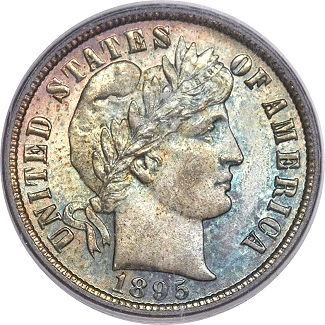 Coins that graded 65 in the past may be certified by the same service as grading 66 or 67 in the present. Alternately, I know of one very important large cent that was PCGS graded 63 in the past, though will not be graded higher than 58 by PCGS in the present. Besides, PCGS started assigning ‘plus’ grades in March 2010.
Coins that graded 65 in the past may be certified by the same service as grading 66 or 67 in the present. Alternately, I know of one very important large cent that was PCGS graded 63 in the past, though will not be graded higher than 58 by PCGS in the present. Besides, PCGS started assigning ‘plus’ grades in March 2010.
In any event, the 1895-O is the rarest business strike in the series of Barber dimes. Not one has ever been PCGS or NGC graded as MS-67. The CAC population report, though, reports three at the MS-66 level and experts at CAC ignore the ‘plus’ aspect of plus grades assigned by PCGS or NGC.
This 1895-O, from “The Lily Nicole Collection,” brought $54,050, which is a retail price and very appropriate as such. This exact same coin was auctioned by Heritage in August 2006, for $52,900.
Although markets for rare U.S. coins in general peaked in late July 2008, markets for gem quality Barber coins peaked a little earlier. It is significant that this 1895-O dime sold for around the same price this month as it did during a peak period for gem Barber coins.
1875-CC Twenty Cent piece
The PCGS graded “MS-66+” and CAC approved 1875-CC Twenty Cent piece in this auction brought $51,700, a solidly moderate price, neither strong nor weak. The PCGS graded MS-66, and CAC approved, Gene Gardner piece went for $49,937.50 on June 23, 2014. That 1875-CC might be a little more attractive than this one. A different PCGS graded MS-66 and CAC approved coin realized $48,875 on August 12, 2011. There is much evidence to support my hypothesis that prices for rare U.S. coins have remained, more or less, the same for years.
Newman 1833 Bust Quarter
The Newman-Green, NGC graded MS-65, 1833 quarter did not sell on April 23, 2015. The reserve last week was more than $20,000, however, well above the price realized at the Newman sale of November 2013, $17,625. That sale was characterized by Newman mania and bidding then was often hysterical. It did not make sense for a consignor to place such a reserve on this 1833 quarter in April 2015.
Besides, it is unlikely that experts at either PCGS or CAC would grade this coin as MS-65. An unexciting reverse, hairlines in the right obverse inner fields, and some indentations on Miss Liberty’s face, all suggest that 65 is too high a grade. In 2013, I graded it as MS-64.
Liberty Seated Quarters
When I saw the pictures of the PCGS graded “MS-66+” 1839 quarter in the auction catalogue, I knew that I had seen this coin before, though I never saw an 1839 quarter in a holder with a “MS-66+” grade printed on the label. After checking my notes, I became aware that this 1839 was formerly in the Gene Gardner Collection and was NGC graded MS-67 when it was auctioned for $52,875 in October 2014. Moreover, I had seen it at an earlier time as well. Bowers & Merena (New Hampshire) auctioned this same quarter in 1998 for $39,100, perhaps in Baltimore.
 The buyer in October or someone else had it downgraded to “66+” and re-stickered, though I guess that the experts at CAC would not agree with the “+” aspect of the latest certified grade. Its grade just barely makes it into the middle of the 66 range. Nonetheless, it is an excellent coin and could be the finest known 1839 ‘No Drapery’ quarter.
The buyer in October or someone else had it downgraded to “66+” and re-stickered, though I guess that the experts at CAC would not agree with the “+” aspect of the latest certified grade. Its grade just barely makes it into the middle of the 66 range. Nonetheless, it is an excellent coin and could be the finest known 1839 ‘No Drapery’ quarter.
The $64,625 result on April 23 is strong, though understandable. It would be a wonderful addition to a type set.
I do not now have a recollection of ever having seen the PCGS graded MS-66+, and CAC approved, 1854 quarter in this auction. The $28,200 result is probably a little weak. All 1854 quarters have arrows and are particularly important as representatives of a type that was minted for just three years.
The 1860-S is not a type coin. It is a semi-key of the ‘No Motto’ Liberty Seated quarter series. Indeed, it could be fairly termed a key, behind the 1849-O. The PCGS graded and CAC approved, MS-61 1860-S is the highest certified and is likely to be the finest known.
This same 1860-S was in the Gene Gardner Collection. It was NGC graded MS-61, and CAC approved, when it sold for $55,812.50 on October 27, 2014. It did not sell on April 23, and the reserve was more than $70,000! It is the same coin now that it was six months ago, just in a different holder, and no longer fresh. I viewed it in October and found it to be exceptionally pleasing for a 61 grade coin. If not for a little light friction and a few rather deep hairlines, it would qualify for a much higher grade.
This is the only 1860-S that PCGS has graded above 45! The NGC printed label (‘insert’) for this one has been returned to NGC and the current NGC census reports just six above 45, the highest of which is a single coin that is NGC graded as AU-58. So, the Gardner coin in this auction might tower above all other 1860-S quarters.
Gem 1900-S Barber Quarter
After I saw a PCGS graded and CAC approved MS-67 1900-S quarter, a semi-key, listed in the catalogue, I became a little disappointed that I did not view it in actuality, as I have seen almost every superb quality, better date Barber quarter. After a little research, it became apparent that it was auctioned by Heritage in August 2006, at a convention that I was unable to attend.
In 2006 or earlier, this 1900-S was NGC graded as MS-67. CAC was not founded until September or October 2007. In 2006, this coin sold for $6325. On April 23, 2015, it brought $11,750!
Draped Bust, Heraldic Eagle Halves
There was a commendable offering of Draped Bust, Heraldic Eagle halves in this auction. The 1801 and the 1802 are the rarest dates of the type. A PCGS graded and CAC approved AU-55 1802 sold for $30,550. A moderate price is around the border of the wholesale and retail price ranges for the particular coin, and this $30,550 result is probably a little below. I would need to view the coin to form a firm opinion.
There were two highly certified 1806 halves with a ‘pointed six,’ which is slightly scarcer than the 1806 over inverted 6. Most interested collectors would be happy to own one 1806 half and would not care much about the die characteristics of the numerals
A PCGS graded and CAC approved MS-65 1806 realized $88,125, a moderate to strong price. Another 1806 ‘pointed six’ that is PCGS and CAC graded MS-65 sold for $92,000 in January 2010.
The NGC graded MS-65 1806 half in this auction brought just $51,700. This same exact coin also realized an apparently weak price in May 2009, $46,000. I would have to see the coin to form a hypothesis as to why it did not sell for more. It might be true that some pertinent bidders have graded it as MS-64 or there could be other reasons. It is hard to imagine an 1806 half that most relevant experts grade as MS-65 selling for less than $62,500 in a major coin auction.
Gem ‘No Motto’ Half Eagles
Unfortunately, it is not practical to now analyze the amazing run of ‘No Motto’ Liberty Head Half Eagles in this auction. Several were earlier in the epic set assembled by the late Ed Milas, which Stack’s (NY) auctioned in 1995. Two are especially newsworthy, though the 1861 was probably never in Milas’ collection.
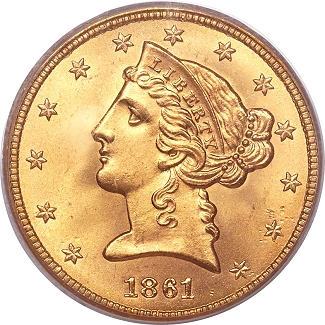 The PCGS graded MS-66, and CAC approved, 1861 brought $152,750, an extremely strong price. The Milas 1852, in contrast, may have been one of the best values in the auction. In 1995, this half eagle was auctioned for $66,000. The Milas 1852 was then NGC graded MS-66, and it is now CAC approved. On April 23, 2015, it sold for just $76,375. If I am accurately remembering the coin, which admittedly is a little hazy in my mind, this is a surprisingly weak price.
The PCGS graded MS-66, and CAC approved, 1861 brought $152,750, an extremely strong price. The Milas 1852, in contrast, may have been one of the best values in the auction. In 1995, this half eagle was auctioned for $66,000. The Milas 1852 was then NGC graded MS-66, and it is now CAC approved. On April 23, 2015, it sold for just $76,375. If I am accurately remembering the coin, which admittedly is a little hazy in my mind, this is a surprisingly weak price.
1849-C ‘Open Wreath’ One Dollar Gold
The NGC certified “MS-63 Prooflike” 1849-C ‘Open Wreath’ One Dollar Gold piece is the finest of five known of this variety. As to whether the “open wreath” is significantly different from the relatively “close wreath” on the reverse, each interested collector should reflect upon the matter and draw his or her own conclusion. Louis Eliasberg did not believe that this variety was needed for a set of U.S. One Dollar Gold pieces, and chose not to buy the ones that were offered to him.
The $493,500 result for this 1849-C ‘Open Wreath’ is not easy to interpret. This coin is fresh. It was auctioned by the firm of David Lawrence in July 2004, and sold privately in 2005.
As far as I know, it was not openly offered between 2005 and the current auction. In 2004, when it brought $690,000, I covered the event for Numismatic News newspaper. Although some reports imply, or unintentionally give the impression, that this coin was in the epic Richmond Collection, this is not true. It was the one coin in the catalogue of the gold coins of the Richmond Collection that had never been in the Richmond Collection.
The $690,000 result then was extremely strong. The current $493,500 result seems weak to moderate, perhaps in line with the $218,500 price realized for the NGC graded EF-45 coin of the same variety that was sold at a Long Beach Expo in February 2010.
There were many more silver and gold rarities in this event than could be covered in this discussion. It is clear that rarities fared well in the auction. To understand auction results for coins, there is a need to think beyond the plastic holders and reflect upon the physical characteristics of the coins and pedigrees. Although I could not ‘view the sale’ this time, I had seen many of the coins offered in the past.
Prices that might seem weak or very strong to people who have not seen the coins are often just moderate, in line with market realities. In order to understand auction results, there is often a need to carefully examine individual coins or discuss their respective characteristics with straightforward experts who have viewed them.
©2015 Greg Reynolds


